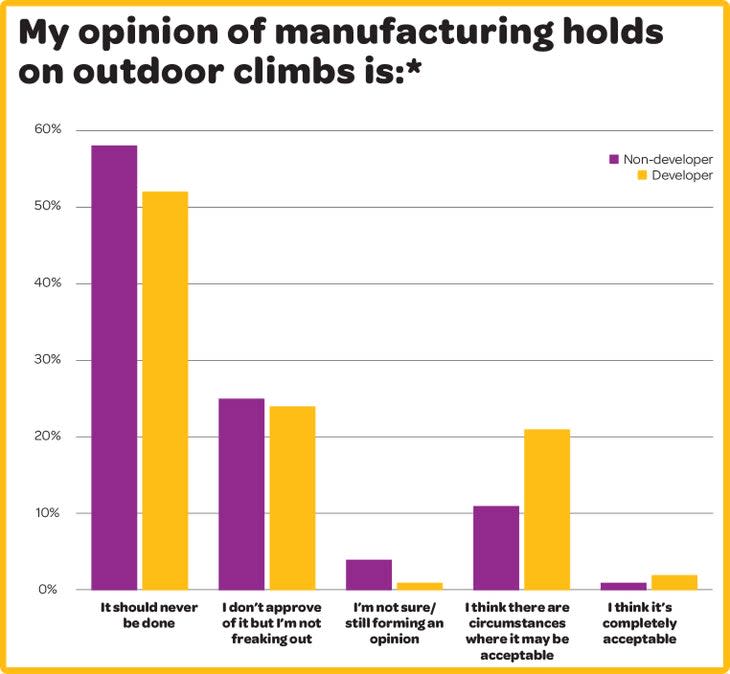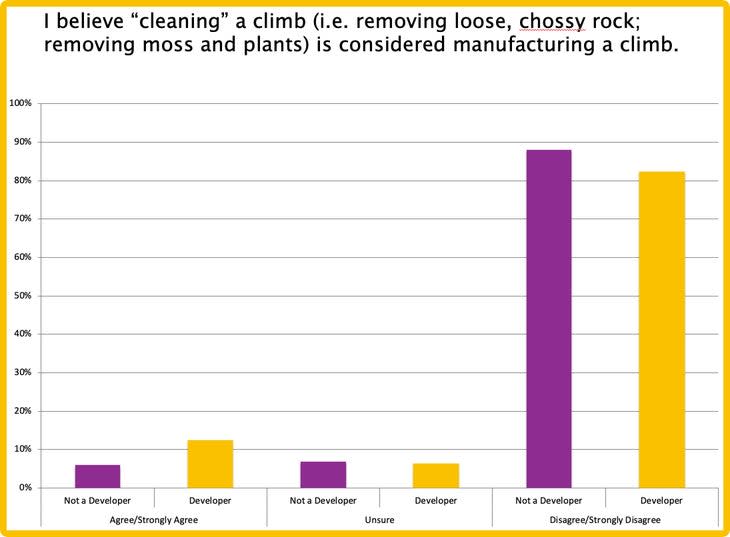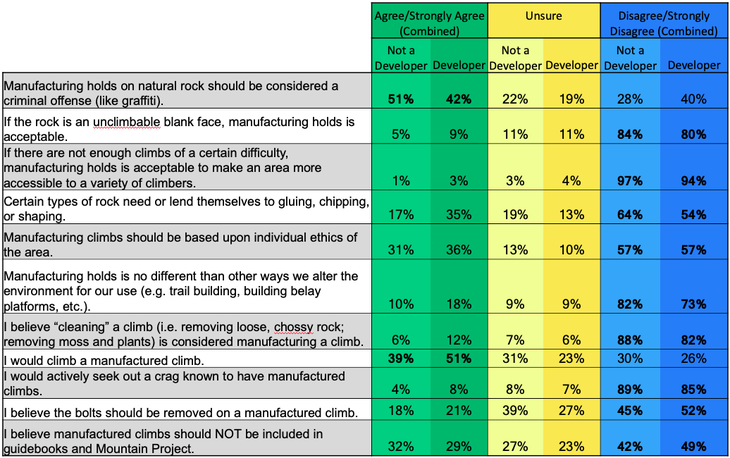We Asked, You Answered: Is Chipping Holds Acceptable in Climbing?
This article originally appeared on Climbing
This article was originally published in 2019.
Reinforcement and filing versus chipping and drilling. Scaling away hundreds of pounds of surface choss versus excavating a few ounces of stone to make a climb "go." Manufacturing one hold to make a climb consistent versus drilling 30 to make a would-be 5.13 into a 5.11. A purist might argue that manufacturing means altering the rock from its natural state--period--while a realist might argue that there are many shades of gray.
Chipping has long been a heated topic, brought to the forefront recently by reports of heavily manufactured climbs at a popular Western climbing area. It may seem like the topic is cut-and-dry--"Just don't do it" and call it good. But, with the recent controversies and increasing popularity of climbing, coupled with the lack of formal definitions around what constitutes "manufacturing," it may be time to revisit the conversation. To get a sense of the climbing community's take, Climbing and I conducted a survey in February 2019.

Some 1,080 climbers responded, with a surprising percentage (44 percent) indicating they have developed routes. It's difficult to determine whether this large number is a response bias (i.e., route developers felt more compelled to respond versus non-developers) or whether this is a reflection of increased interest in route development--it could be a bit of both, but given how few people actually install new climbs versus repeat them, it's likely weighted toward the former scenario.
The graphic at the top of this page shows the breakdown of responses, separated into developers versus non-developers. In most cases, there is very little difference between the two populations, with the vast majority not agreeing with manufacturing holds. However, there are also some important differences, with 22 percent of developers indicating "I think there are circumstances where [manufacturing holds] may be acceptable" versus 11 percent of non-developers. This is likely a reflection of experience, which becomes clear when reading the comments--developers have been faced with tough decisions often driven by circumstance. Such perception-differences are certainly fodder for further conversation.
The survey yielded 563 open-ended comments, many thoughtful, passionate, and lengthy. A significant number of commenters--both developers and non-developers alike--defended the sanctity of nature and the rock, stating things like "leave it pure," "only remove what is dangerous," and "let the rock reveal the natural line." However, the process is not always so straightforward:
Many feel that quarries, dynamited roadside cliffs, and private land (i.e., "It's their land--people can do what they want") are fair game, whereas there should be no manufacturing on public land.

Removing loose rock for safety is viewed as distinct from "manufacturing." Some 85 percent of respondents disagreed or strongly disagreed with the statement "I believe 'cleaning' a climb (i.e., removing loose, chossy rock; removing moss and plants) is considered manufacturing." But, there may be some gray areas here as well. Numerous comments conveyed the reality that, in some areas, developers need to remove significant amounts of rock to make the cliff "safe"--and this acceptable level of cleaning (to us) may not be so to land managers. It also raises philosophical questions like: Is it still a "natural" line when thousands of pounds of rock have to be removed to for it to be climbable?
Numerous comments differentiated between manufacture of an entire route ("completely unacceptable") versus exceptions for shaping just one or two holds on a long climb (i.e., a roped route). An important criterion was that the holds look natural and be in character with the route and the rock. Some argued that drilling a bolt ladder in a blank section (which historically has been viewed as acceptable) would be more destructive and less visually appealing than chipping a few natural-looking holds. In this vein, a number of people made the distinction that a climb that is 95 percent 5.10 but has two 5.15 moves is a terrible climb for both 5.15 and 5.10 climbers--thus enhancing a couple holds creates a usable, quality climb. Counter-arguments in the comments note that "not every rock needs to be climbed," while others state, "If you lived in an area with very few climbing options, you might feel differently."
Reinforcement and filing versus chipping and drilling. Scaling away hundreds of pounds of surface choss versus excavating a few ounces of stone to make a climb "go." Manufacturing one hold to make a climb consistent versus drilling 30 to make a would-be 5.13 into a 5.11. A purist might argue that manufacturing means altering the rock from its natural state--period--while a realist might argue that there are many shades of gray.
Chipping has long been a heated topic, brought to the forefront recently by reports of heavily manufactured climbs at a popular Western climbing area. It may seem like the topic is cut-and-dry--"Just don't do it" and call it good. But, with the recent controversies and increasing popularity of climbing, coupled with the lack of formal definitions around what constitutes "manufacturing," it may be time to revisit the conversation. To get a sense of the climbing community's take, Climbing and I conducted a survey in February 2019.
Based on the comments, glue reinforcement of existing holds appears to be marginally acceptable (such as at chossy limestone crags like Rifle), as was using glue to repair a historic climb damaged by overuse. However, a sloppy glue job was heavily frowned upon, as was gluing on a chunk of rock that wasn't there in the first place.
Lastly, "comfortizing," such as smoothing down razor-sharp edges, was generally not viewed as manufacturing, but a purist might argue otherwise (same with gluing).
A natural question is, Where do we go from here? To begin, we need to establish well-defined, "acceptable" norms for development--which also means taking a good, hard look at ourselves and acknowledging the disconnects between our expressed beliefs and our behaviors.
For example, despite our clear condemnation of manufacturing, either passing time or willful ignorance allows us to elevate numerous climbs with known manufactured holds to "classic" status. The Phoenix (5.13a) in Yosemite--with its pin scars, as are commonly found on many difficult Valley free climbs, including the Salathe Wall, Zodiac, etc.--and Just Do It at Smith Rock (5.14c)--with its drilled holds--are only two examples. The latter, especially, is much celebrated, as with Paige Claassen's 2014 first female ascent or Adam Ondra's 2018 onsight. Even the Nose has chipped holds, on the 5.11 Jardine Traverse, and various pin scars, a fact we seem to conveniently forget.
To continue in this vein, we seem unwilling to chop the bolts on a "manufactured" climb, to hide its existence from public view, or to not climb it at all (see survey results online). I wonder, then, is it hypocritical to throw developers under the bus and then merrily climb their routes, exclaiming, "Well, it's there now--let's do it!"? Maybe a relevant question to ask is, What is it that makes one climb with manufactured holds acceptable and another not? Is stating, "It was made 30 years ago," a legitimate excuse when there are plenty of more recently established climbs with "manufactured" holds that we rave about? And also, what is it within ourselves that allows us to justify climbing those routes if we truly hate what they represent?
As I compiled the survey results, I began pondering these questions. I have discovered that I, too, am guilty of the double standards illuminated above. Once we face our own internal hypocrite and identify what we truly want as individuals and a community, then we can develop reasonable and realistic ethical standards that align reality with ideals. All of us can be more appropriately held accountable--not just developers.
Perhaps the place to begin is a national conversation that includes stakeholders like route developers, climbers (young and old), land managers, and national climbing organizations like the Access Fund and the American Alpine Club. (Survey results show that 57 percent of people disagree with the statement "Manufacturing climbs should be based upon individual ethics of the area [emphasis added].") This could help generate clear definitions around what constitutes "manufacturing," what is acceptable, and why.
Would making such language "official" risk bringing negative attention to our sport from land managers? Perhaps, but highly visible online squabbles rarely advance the conversation either. We need to ask the hard questions and identify the disconnects between our beliefs and our actions. If we don't proactively engage and advance the entire route-development conversation, then the terms will get set for us--and they may not be terms we like.
Survey Comments:
The practice of manufacturing holds with a drill should be widely discouraged. That said, it can not be completely condemned. There are numerous classics that wouldn’t go free (including the Nose on El Captain) if it weren’t for rock modification. I am a minimalist when it comes to chipping, enhancing or blatant manufacturing. I only use the tactic in a very blank section to create a hold or two to link a line of natural holds. I have been climbing for 46 years. I have established trad routes going back to the 1970s, mixed routes since the 1980s, and hundreds of sport routes from 1991 to 2017. Most of the routes (99.9%) I have established are 100% natural. I prefer what nature gives us. That said, I’ve modified holds through cleaning and even manufactured about a dozen holds on various climbs. I have used a drill to manufacture a few holds but not since 2000. I had been climbing for 23 years when I first used a drill to widen an existing seam on overhanging rock. I decided it was too easy to create a hold. I have never manufactured a nice jug. I have chipped a few holds (usually small edges) with a chisel or hammer. I have never manufactured holds simply because the climb is too difficult for me. I have bolted numerous routes I couldn’t free climb, but knew it would eventually go. I’ve walked away and left it for stronger climbers. I don’t encourage the practice of manufacturing holds because it is a slippery slope. Generally I frown upon the practice, but there are exceptions to every rule. There are some classics that wouldn’t exist if it weren’t for some type of hold creation. Take the crack climb The Phoenix in Yosemite as an example. Ray Jardine pin scarred a short thin section to make finger jams so the route was possible, thus creating America’s first 5.13a.
* * *
Making new routes is like making sausage. Almost everybody loves it, but nobody wants to think about what goes into it. Heavy processing can lead to bland results but if done well it makes otherwise unpalatable scraps into something many can enjoy.
* * *
My view of (outdoor) climbing is that it is about coping with what nature provides. Sport climbing already violates this concept, because it takes nature out of the protection part of the equation. OK, so be it; that ship has sailed long ago, carrying, however, the burden of an “original sin” that now spreads from drilling protection to drilling holds. But when the holds themselves are manufactured, the absolute core of the enterprise is compromised, and we are left with the self-serving carving up of the natural environment for the entertainment of a few enthusiasts. It is base, egotistical, and entitled to sculpt nature’s intrinsic challenges into sanitized versions for some vision of popular consumption. And the fundamental ingredient that makes climbing what it is, the voluntary renunciation of all possible means, suffers a mortal blow.
* * *
Re-manufacturing/gluing holds that have broken is generally OK if it restores the original move of the route. Fully manufactured routes are no bueno. “Comfortizing” holds is a case-by-case basis and should never make the hold easier, just less painful. There should never be more than two manufactured holds on a single route.
* * *
I think the best example I have of this phenomenon is a route at The Pit in Flagstaff, Total Recall. It has one drilled pocket at two thirds height that completely changes the character of the route, keeping it consistent throughout. I am likely the only person to ever do the route without using the pocket (which has been filled in and then re-drilled at least once) and can comfortably say, the route is much better with the pocket.
Taking a predominately natural line, and slightly altering, can be acceptable if done with the consent of the local community, and done well by the developer. I would not tend to do this, because I lack the skill to do it right. However, in my local area, where we have soft sandstone, reinforcing keeps our routes from disintegrating, and it is always done on consensus. Similarly, our limestone requires cleaning--it is low quality--and the border between manufacturing and cleaning really doesn’t exist.
That said, I am opposed to primarily manufactured routes. Drilling a route down to your level, adding a gym route up a blank wall, etc., while often fun, should generally not be done. Jacks comes to mind, an area deserving of its poor reputation for the heavy handed manufacturing--although a very fun place to climb.
For exclusive access to all of our fitness, gear, adventure, and travel stories, plus discounts on trips, events, and gear, sign up for Outside+ today.


